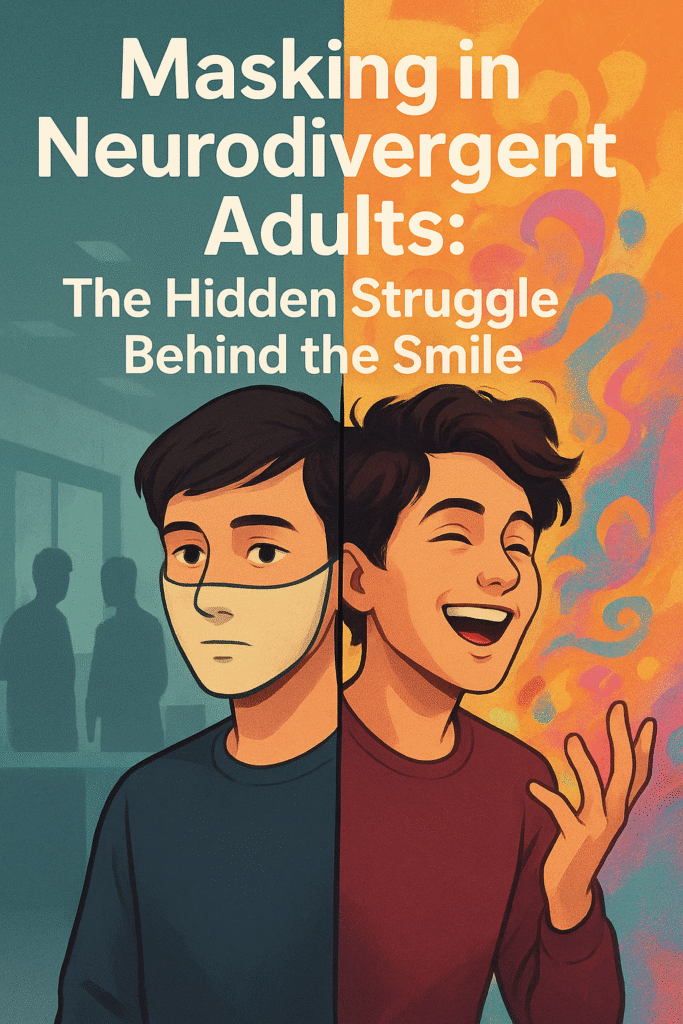
⚠️ Affiliate Disclaimer: This post may contain affiliate links, which means I may earn a small commission — at no extra cost to you — if you make a purchase through one of these links. I only recommend products or services I genuinely trust and believe can provide value. Thank you for supporting My Medical Muse!
Masking in Neurodivergent Adults: Understanding the Hidden Struggle
Masking in Neurodivergent Adults: The Hidden Struggle Behind the Smile
For many neurodivergent adults, particularly those with autism, ADHD, dyslexia, dyspraxia, or other cognitive differences, life often feels like living in two worlds. There is the authentic self, with unique ways of thinking, behaving, and experiencing the environment, then there is the “masked” self, carefully shaped to blend into a neurotypical society that may not fully understand or accept them.
This act of masking is not merely about politeness or adapting to social cues, it’s an exhausting performance designed to avoid judgment, exclusion, or even discrimination. While masking can provide short-term safety, the long-term costs can be devastating to mental health, relationships, and self-identity.
In this article, we’ll explore what masking looks like in neurodivergent adults, why it happens, its emotional and physical toll, and how individuals can move toward unmasking and authentic living.
What Is Masking?
Masking, also known as camouflaging, refers to the strategies neurodivergent people use to hide, suppress, or downplay traits that might reveal their differences. It is not about occasional politeness or adapting to specific situations, it is a systematic effort to appear “neurotypical” in a world that often doesn’t accept or understand cognitive diversity.
Masking can be either conscious, where someone deliberately modifies their behavior or unconscious, where years of social conditioning have made the behavior automatic. Over time, it can become so ingrained that many adults don’t even realize they’re masking until they experience burnout or begin reflecting on their lived experiences.
Some common ways masking shows up include:
- Mimicking neurotypical behaviors: Forcing eye contact, copying gestures, or rehearsing jokes and small talk to appear socially fluent.
- Suppressing natural responses: Avoiding stimming (rocking, tapping, hand-flapping), holding back enthusiasm, or resisting the urge to interrupt even when excitement feels overwhelming.
- Over-preparing for interactions: Scripting conversations, practicing responses, or mentally running through scenarios to avoid awkward pauses.
- Concealing difficulties: Pretending to understand instructions, hiding forgetfulness, or covering up executive function struggles.
For instance, an autistic adult may push themselves to maintain eye contact despite the sensory discomfort, while someone with ADHD might channel immense energy into staying still during a long meeting, even though their focus would improve if they could move.
Ultimately, masking is less about choice and more about survival. Most neurodivergent adults learn these behaviors early in life as a way to avoid rejection, criticism, or exclusion.
Why Do Neurodivergent Adults Mask?
Masking is rarely about vanity or deception, it is a response to social pressures and expectations. The motivations behind masking are layered and deeply personal, but several common themes emerge:
1. Social Acceptance
From an early age, many neurodivergent people are taught directly or indirectly that their natural behaviors are “wrong” or “too much.” Masking becomes a way to fit in, make friends, and avoid the painful experience of being singled out as different.
2. Professional Success
Workplaces often reward conformity to unwritten rules: firm handshakes, quick small talk, “appropriate” levels of eye contact. For neurodivergent adults, masking helps them appear competent and reliable, even if it takes a significant emotional and physical toll.
3. Safety from Bullying or Stigma
For many, the roots of masking go back to childhood. Being bullied for “odd” behaviors or scolded by teachers for not fitting in teaches children that hiding their differences keeps them safer. As adults, this fear of judgment or rejection continues to drive masking.
4. Internalized Ableism
Society often sends subtle messages that neurodivergent traits are flaws rather than differences. Over time, these messages can lead adults to internalize shame, believing they must hide their authentic selves to be worthy of acceptance. Masking becomes an attempt to meet these unrealistic “normal” standards.
5. Avoiding Misunderstandings
Explaining neurodivergence to others can be exhausting, especially when met with skepticism or dismissal. Many adults choose masking simply because it feels easier than constantly educating or justifying their needs.
The Forms of Masking
Masking is not a single behavior, it shows up differently depending on context and the individual’s neurodivergence. Understanding the forms of masking helps highlight just how multi-layered and draining it can be.
1. Social Masking
This is the most visible form of masking and often happens in group settings:
- Pretending to enjoy social gatherings even when overstimulated or drained.
- Nodding along in conversations despite feeling lost, simply to avoid asking for clarification.
- Mirroring others’ tone, body language, or slang to blend in.
An autistic adult at a party may study others’ behavior to know when to laugh or how to join conversations, while ignoring their own discomfort with noise and crowds.
2. Emotional Masking
This involves suppressing or altering emotional expression:
- Hiding excitement or joy to avoid being seen as “too intense.”
- Minimizing sadness or frustration, often using humor or sarcasm as a cover.
- Smiling through distress to appear “fine.”
An ADHD adult may crack jokes about their forgetfulness, masking the anxiety they actually feel about being perceived as unreliable.
3. Behavioral Masking
This focuses on minimizing outward behaviors that may seem unusual:
- Hiding or replacing stimming with more “socially acceptable” alternatives like tapping a pen or playing with jewelry.
- Forcing physical stillness when the body craves movement.
- Carefully monitoring voice tone or speech patterns to avoid being labeled “awkward.”
A dyspraxic adult may avoid group sports or physical games to hide coordination difficulties, even though they might enjoy the activity.
4. Cognitive Masking
Perhaps the least visible, this involves mental overcompensation:
- Working twice as hard to manage executive function challenges.
- Memorizing instructions, scripts, or responses to mask difficulties with processing information in real-time.
- Relying on perfectionism to prevent mistakes that might reveal struggles.
A dyslexic adult may memorize entire passages for meetings instead of reading them, hiding their difficulty with written text.
The Hidden Costs of Masking
While masking can make day-to-day interactions smoother, the long-term consequences are significant. It’s like running a marathon every single day while wearing a heavy costume, eventually, the effort catches up.
1. Exhaustion and Burnout
Masking requires constant vigilance: monitoring body language, censoring speech, suppressing impulses, and anticipating how others might react. This ongoing self-surveillance drains energy, leaving little left for creativity, problem-solving, or relaxation.
Over time, this can lead to autistic burnout or ADHD burnout, states of intense fatigue, irritability, sensory overload, and even loss of skills that once felt manageable. Unlike ordinary tiredness, burnout can last weeks or months, severely disrupting work, relationships, and overall functioning.
2. Loss of Identity
When someone spends years pretending to be a version of themselves that feels more acceptable, it can blur the line between performance and authenticity. Many neurodivergent adults report feelings like:
- “I don’t know who the real me is anymore.”
- “Have I been faking my personality my whole life?”
This disconnect can erode self-confidence and make it difficult to pursue genuine passions, relationships, or goals.
3. Mental Health Challenges
The psychological toll of masking is profound. Studies consistently link chronic masking with heightened risks of:
- Anxiety: from constantly second-guessing one’s behavior.
- Depression: from suppressing natural self-expression.
- Social withdrawal: when the effort of maintaining the mask becomes unbearable.
- Suicidal ideation: in severe cases, when the sense of isolation and inauthenticity feels overwhelming.
The emotional labor of masking is invisible to others, which can intensify feelings of loneliness and despair.
4. Relationship Difficulties
Masking doesn’t just affect the individual, it impacts connections with others. When friends, colleagues, or partners only know the “masked” version, relationships may feel shallow or unsatisfying.
Later, if someone begins to unmask, others might misinterpret it as “changing” or “becoming difficult,” when in reality they are finally showing their authentic self. This mismatch can create tension, misunderstandings, or even fractured relationships.
5. Physical Health Impacts
The body often carries the weight of chronic masking. Prolonged stress activates the body’s fight-or-flight system, leading to:
- Frequent headaches or migraines
- Digestive issues such as IBS
- Difficulty falling or staying asleep
- Weakened immunity, making illness more common
What starts as a coping strategy for social survival can, over time, undermine both mental and physical health.
Masking Across Different Neurodivergences
Masking is not limited to one condition, it shows up differently across the neurodivergent spectrum.
Masking in Autistic Adults
Autistic masking often involves forcing eye contact, imitating speech rhythms, or suppressing stimming behaviors. Many autistic adults also adopt “social scripts” to navigate conversations. Autistic women and nonbinary people, in particular, are more likely to mask, contributing to delayed or missed diagnoses since their differences are less visible.
Masking in ADHD Adults
ADHD masking tends to center on hiding restlessness or distractibility. Adults may over-prepare for meetings, double-check tasks obsessively, or lean on humor to cover lapses in focus. This overcompensation often looks like perfectionism but behind the scenes, it’s fueled by fear of being perceived as lazy or careless.
Masking in Dyslexia and Dyspraxia
Adults with dyslexia may avoid reading aloud, memorize text instead of processing it in real-time, or use clever workarounds to conceal difficulties. Dyspraxic individuals may decline invitations to sports or dance classes to avoid embarrassment, masking their challenges by simply “not participating.”
Overlapping Experiences
Many neurodivergent adults have co-occurring conditions, making masking layered and complex. For example, an autistic person with ADHD may simultaneously suppress stimming and over-prepare for conversations, masking on multiple levels at once.
Unmasking: The Path to Authentic Living
Although masking may feel like a necessity, it’s not the only way to live. Unmasking, gradually letting go of these survival strategies can lead to greater authenticity, mental health, and self-acceptance. Still, unmasking is not always simple or safe, especially in environments that lack understanding.
Step 1: Self-Awareness
The first step is noticing the mask. Reflect on:
- When do you feel the need to perform or adjust yourself?
- Which behaviors feel natural, and which feel forced?
- How does your body react after long periods of masking (e.g., exhaustion, headaches, irritability)?
Journaling or discussing these observations with a trusted therapist can help clarify patterns.
Step 2: Safe Spaces
Unmasking requires trust. Start with environments where judgment is minimal, supportive friends, family, or neurodivergent communities. Online groups can also provide encouragement and validation, offering a place to “practice” unmasking before bringing it into everyday life.
Step 3: Therapeutic Support
Working with a neurodivergent-affirming therapist can be transformative. Therapy provides tools to process the emotions tied to masking, rebuild a sense of identity, and set boundaries for when and where unmasking feels safe.
Step 4: Disclosure and Advocacy
Some adults choose to disclose their neurodivergence at work or in personal relationships. While this is a highly personal decision, disclosure can reduce the pressure to mask and open doors to accommodations. Beyond the individual level, advocacy helps shift cultural expectations, making unmasking safer for others.
Step 5: Self-Compassion
Perhaps the most important step is recognizing that masking served a purpose. It was never weakness, it was survival. Practicing self-compassion reframes unmasking not as regret for the years spent hiding, but as a courageous step toward reclaiming authenticity.
The Role of Society: Reducing the Need for Masking
It’s important to remember that masking is not an individual failing, it is a response to societal barriers. Neurodivergent adults do not mask because they want to deceive, they mask because environments are often hostile to difference. Reducing the burden of masking requires collective responsibility and systemic change.
Workplaces
Work is one of the environments where masking is most common, often at the expense of mental health. To foster inclusion, workplaces can:
- Create flexible policies that allow for different communication styles, flexible schedules, or remote work options.
- Support sensory needs by providing quiet rooms, noise-cancelling options, or flexible lighting.
- Train managers and HR teams to recognize and support neurodivergent employees, reducing stigma and encouraging open dialogue.
When workplaces embrace neurodiversity, employees no longer need to hide their differences just to be seen as competent. This not only benefits individuals but also enhances creativity and innovation within organizations.
Education
Masking often begins in childhood, shaped by the pressures of school environments that reward conformity. Change must start early:
- Encourage self-advocacy instead of forcing children to suppress traits like stimming or fidgeting.
- Normalize difference in classrooms by teaching all students about neurodiversity.
- Prioritize early diagnosis and accommodations, helping children develop strategies that support their authentic selves rather than forcing them to mask.
A supportive education system can prevent years of masking and its associated costs, setting the stage for healthier adulthood.
Communities
True change happens when society at large embraces neurodiversity. Communities can play a powerful role by:
- Promoting acceptance of diverse communication styles, whether that means directness, silence, or alternative forms of expression.
- Normalizing behaviors like stimming, fidgeting, or avoiding eye contact, treating them as natural variations rather than “problems.”
- Building inclusive spaces from social clubs to public events that welcome difference without judgment.
When communities shift their perspective from tolerance to genuine acceptance, the pressure to mask decreases, and neurodivergent adults can participate more fully and authentically.
Moving Forward: Embracing Neurodivergence
Unmasking does not mean abandoning all social skills or disregarding the need for context. Rather, it is about choosing authenticity without fear, granting yourself the freedom to stim, to speak honestly, to ask for clarification, or to admit when situations feel overwhelming. It is about living in a way that honors your natural tendencies while still navigating the world safely and effectively.
The path to unmasking is gradual, deeply personal, and often requires both courage and support. Key steps along this journey may include:
- Building self-acceptance: Recognize that neurodivergence is not a flaw to be “fixed,” but a natural variation in human cognition. Embracing your differences allows you to value your strengths and acknowledge challenges without shame.
- Nurturing supportive relationships: Surround yourself with people, friends, family, colleagues, or mentors who celebrate your authentic self. Safe, understanding spaces allow you to practice unmasking without fear of judgment, creating deeper and more meaningful connections.
- Advocating for cultural change: Personal unmasking is empowering, but systemic change amplifies the impact. By raising awareness, educating others, and promoting inclusive environments, neurodivergent adults can help ensure that future generations will not feel compelled to hide their differences to belong.
As awareness of neurodiversity grows, the hope is that tomorrow’s adults will thrive without the heavy burden of masking. Rather than being pressured to adapt at all costs, neurodivergent individuals will be celebrated for the unique perspectives, creativity, and problem-solving skills they bring to every aspect of life, be it in relationships, the workplace, or the broader community.
Ultimately, embracing neurodivergence is not just a personal journey; it is a collective opportunity to reshape society into a place where authenticity, difference, and diversity are valued as strengths rather than obstacles.
Conclusion
Masking in neurodivergent adults is both a shield and a burden. While it can provide temporary protection from misunderstanding, judgment, or social exclusion, it comes at a high cost. Over time, the effort required to hide authentic traits can erode self-confidence, drain emotional and physical energy, and take a serious toll on mental health. What begins as a coping strategy often transforms into a long-term barrier to self-expression and well-being.
Recognizing the hidden costs of masking is the first step toward meaningful change. Supporting neurodivergent individuals in their journey to unmask through safe spaces, understanding relationships, inclusive workplaces, and neurodiversity-affirming communities can dramatically improve quality of life. By creating environments where differences are valued rather than concealed, society allows neurodivergent adults to reclaim their identities, reduce burnout, and live authentically.
Living authentically is not solely a personal victory; it is a collective responsibility. Every person, community, and institution has a role to play in dismantling the social pressures that make masking necessary. When neurodivergent adults feel safe to unmask, everyone benefits: the richness of diverse minds, unique perspectives, and creative problem-solving becomes accessible to the broader community.
Ultimately, unmasking is more than just a personal act, it is a step toward a society that embraces difference as a strength rather than a weakness. By valuing authenticity over conformity, we not only empower neurodivergent individuals but also cultivate a culture of empathy, acceptance, and genuine human connection.
👩⚕️ Need Personalized Health Advice?
Get expert guidance tailored to your unique health concerns through MuseCare Consult. Our licensed doctors are here to help you understand your symptoms, medications, and lab results—confidentially and affordably.
👉 Book a MuseCare Consult NowRelated Blog Post You Might Like:
- 20 Powerful Signs of ADHD in Adults That Most People Miss
- 10 Early Signs of Autism in Adults You Shouldn’t Ignore
- Insomnia After Quitting Coffee: 7 Proven Fixes for Better Sleep
- Burnout Symptoms in Men: 7 Powerful Ways to Recover Quickly
- Holistic Mental Health: 12 Proven Natural Strategies for a Happier, Healthier Mind


